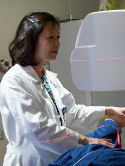| Abstract: |
Purpose: To evaluate the influence of patient- and treatment-related factors on freedom from biochemical failure (FFbF) in patients with intermediate-risk prostate cancer. Methods and Materials: From a prospectively collected database of 2250 men treated at Mount Sinai Hospital from 1990 to 2004 with low-dose-rate brachytherapy for prostate cancer, 558 men with either one or more intermediate-risk features (prostate-specific antigen [PSA] level 10-20 ng/mL, Gleason score 7, or Stage T2b) were identified who had a minimum follow-up of 24 months and postimplant CT-based dosimetric analysis. Biologically effective dose (BED) values were calculated to compare doses from different isotopes and treatment regimens. Patients were treated with brachytherapy with or without hormone therapy and/or external-beam radiotherapy. Patient- and treatment-related factors were analyzed with respect to FFbF. The median follow-up was 60 months (range, 24-167 months). Biochemical failure was defined according to the Phoenix definition. Univariate analyses were used to determine whether any variable was predictive of FFbF. A two-sided p value of <0.05 was considered significant. Results: Overall, the actuarial FFbF at 10 years was 86%. Dose (BED <150 Gy<sub>2</sub> vs. ≥150 Gy<sub>2</sub>) was the only significant predictor of FFbF (p < 0.001). None of the other variables (PSA, external-beam radiotherapy, Gleason score, treatment type, hormones, stage, and number of risk factors) was found to be a statistically significant predictor of 10-year FFbF. Conclusions: Radiation dose is an important predictor of FFbF in intermediate-risk prostate cancer. Treatment should continue to be individualized according to presenting disease characteristics until results from Radiation Therapy Oncology Group trial 0232 become available. © 2009 Elsevier Inc. All rights reserved. |



